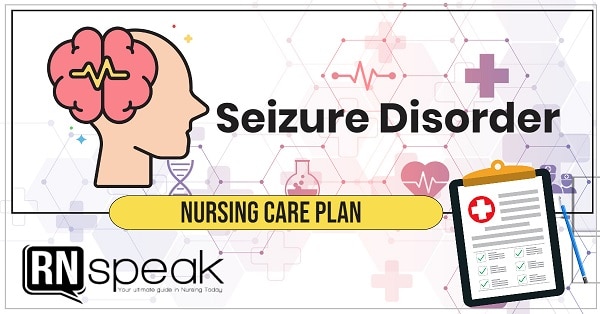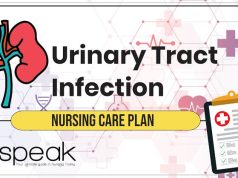Seizure Disorder is a brain disorder that involves recurring disruptions called seizures in the electrical activity in the brain. The brain is a complex electrochemical organ, and the body’s nerves use electric discharges in this electrical network, something like a small storm in the brain.
Experiencing a seizure is not always a symptom of a seizure disorder. A Seizure Disorder involves recurring seizures, so that person must experience at least two to be diagnosed. Many people experience a single seizure during their life and never have another. Seizures are not a sign of mental illness and are not contagious.
Having seizures is not necessarily linked to cognitive impairments and problems processing information, although some of the underlying causes (such as a brain injury) may involve coexisting cognitive problems.
Nursing Priorities
- Prevent/control seizure activity.
- Protect the patient from injury.
- Maintain airway/respiratory function.
- Promote positive self-esteem.
- Provide information about the disease process, prognosis, and treatment needs.
Discharge Goals
- Seizures activity controlled.
- Complications/injury prevented.
- Capable/competent self-image displayed.
- Disease process/prognosis, therapeutic regimen, and limitations understood.
- Plan in place to meet needs after discharge.
2 NCP (Nursing Care Plan) Seizure Disorders – Epilepsy
Nursing Diagnosis: Risk for Trauma/Suffocation
Risk factors may include
- Weakness, balancing difficulties
- Cognitive limitations/altered consciousness
- Loss of large or small muscle coordination
- Emotional difficulties
Evidenced by
[Not applicable; presence of signs and symptoms establishes an actual diagnosis.]
Desired Outcomes
- Verbalize understanding of factors that contribute to the possibility of trauma and/or suffocation and take steps to correct the situation.
- Demonstrate behaviors and lifestyle changes to reduce risk factors and protect oneself from injury.
- Modify the environment as indicated to enhance safety.
- Maintain a treatment regimen to control/eliminate seizure activity.
- Identify actions/measures to take when seizure activity occurs.
| Nursing actions | Rationale |
| Explore with the patient the various stimuli that may precipitate seizure activity. | Alcohol, various drugs, and other stimuli (e.g., loss of sleep, flashing lights, prolonged television viewing) may increase brain activity, thereby increasing the potential for seizure activity. |
| Discuss seizure warning signs (if appropriate) and usual seizure patterns. Teach SO to recognize warning signs and how to care for patients during and after a seizure. | Enables patient to protect self from injury and recognize changes requiring physician/further intervention notification. Knowing what to do when a seizure occurs can prevent injury/complications and decrease SO’s helpless feelings. |
| Keep padded side rails up with the bed in the lowest position, or place the bed up against the wall and pad floor if rails are not available/appropriate. | Minimizes injury should seizures (frequent/generalized) occur while the patient is in bed. Note: Most individuals seize in place, and if, in the middle of the bed, the individual is unlikely to fall out of bed. |
| Encourage patients not to smoke except while supervised. | May cause burns if a cigarette is accidentally dropped during aura/seizure activity. |
| Evaluate the need for/provide protective headgear | The use of a helmet may provide added protection for individuals who suffer recurrent/severe seizures. |
| Use a tympanic thermometer when necessary to take a temperature. | Reduces the risk of patient biting and breaking glass thermometer or suffering injury if sudden seizure activity should occur. |
| Maintain strict bed rest if prodromal signs/aura experienced. Explain the necessity for these actions. | Patients may feel restless/need to ambulate or even defecate during the aural phase, thereby inadvertently removing themselves from a safe environment and easy observation. Understanding the importance of providing for own safety needs may enhance patient cooperation. |
| Stay with the patient during/after the seizure. | Promotes patient safety. |
| Turn head to side/suction airway as indicated. Insert plastic bite block only if the jaw relaxed. | It helps maintain the airway and reduces the risk of oral trauma but should not be “forced” or inserted when teeth are clenched because dental and soft-tissue damage may result. Note: Wooden tongue blades should not be used because they may splinter and break in the patient’s mouth. (Refer to ND: Airway Clearance/Breathing Pattern, ineffective, the risk for |
| Cradle head, place on a soft area, or assist to the floor if out of bed. Do not attempt to restrain. | Gentle guiding of extremities reduces the risk of physical injury when the patient lacks voluntary muscle control. Note: If an attempt is made to restrain the patient during a seizure, erratic movements may increase, and the patient may injure themself or others. |
| Document pre-seizure activity, presence of aura or unusual behavior, type of seizure activity (e.g., location/duration of motor activity, loss of consciousness, incontinence, eye activity, respiratory impairment/cyanosis), and frequency/recurrence. Note whether the patient fell, expressed vocalizations, drooled, or had automatisms (e.g., lip-smacking, chewing, picking at clothes). | It helps localize the cerebral area of involvement |
| Perform neurological/vital sign check after the seizure, e.g., level of consciousness, orientation, ability to comply with simple commands, ability to speak; a memory of incident; weakness/motor deficits; blood pressure (BP), pulse/respiratory rate. | Documents postictal state and time/completeness of recovery to a normal state. May identify additional safety concerns to be addressed. |
| Reorient patient following seizure activity. | Patient may be confused, disoriented, and possibly amnesic after the seizure and need help to regain control and alleviate anxiety. |
| Allow postictal “automatic” behavior without interfering while providing environmental protection. | May display behavior (of motor or psychic origin) that seems inappropriate/irrelevant for time and place. Attempts to control or prevent activity may result in the patient becoming aggressive/combative. |
| Investigate reports of pain. | Maybe the result of repetitive muscle contractions or symptoms of injury incurred, requiring further evaluation/intervention. |
| Observe for status epilepticus, i.e., one tonic-clonic seizure after another in rapid succession. | If left untreated, this is a life-threatening emergency that could cause metabolic acidosis, hyperthermia, hypoglycemia, arrhythmias, hypoxia, increased intracranial pressure, airway obstruction, and respiratory arrest. Immediate intervention is required to control seizure activity and prevent permanent injury/death. Note: Although absence seizures may become static, they are not usually life-threatening. |
| Administer medications as indicated: Antiepileptic drugs (AEDs), e.g., phenytoin (Dilantin), primidone (Mysoline), carbamazepine (Tegretol), clonazepam (Klonopin), valproic acid (Depakene), divalproex (Depakote), acetazolamide (Diamox), ethotoin (Peganone), methsuximide (Celotin), fosphenytoin (Cerebyx); |
Specific drug therapy depends on seizure type, with some patients requiring polytherapy or frequent medication adjustments.AEDs raise the seizure threshold by stabilizing nerve cell membranes, reducing the excitability of the neurons, or through direct action on the limbic system, thalamus, and hypothalamus. The goal is optimal suppression of seizure activity with the lowest possible dose of a drug and the fewest side effects. Cerebyx reaches therapeutic levels within 24 hr and can be used for nonemergent loading while waiting for other agents to become effective. Note: Some patients require polytherapy or frequent medication adjustments to control seizure activity. This increases the risk of adverse reactions and problems with adherence. |
Risk factors may include Nursing Diagnosis: Risk for ineffective Airway Clearance/Breathing Pattern.
- Neuromuscular impairment
- Tracheobronchial obstruction
- Perceptual/cognitive impairment
Evidenced by
[Not applicable; presence of signs and symptoms establishes an actual diagnosis.]
Desired Outcomes
- Respiratory Status: Ventilation
- Maintain effective respiratory pattern with airway patent/aspiration prevented.
| Nursing actions | Rationale |
| Encourage the patient to empty the mouth of dentures/foreign objects if aura occurs and avoid chewing gum/sucking lozenges if seizures occur without warning. | Reduces risk of aspiration/foreign bodies lodging in the pharynx. |
| Place in lying position, flat surface; turn head to side during seizure activity. | Promotes drainage of secretions; prevents the tongue from obstructing the airway. |
| Loosen clothing from neck/chest and abdominal areas. | Facilitates breathing/chest expansion. |
| Insert plastic airway or soft roll as indicated and only if the jaw is relaxed. | If inserted before the jaw is tightened, these devices may prevent biting of the tongue and facilitate suctioning/respiratory support if required. Airway adjunct may be indicated after cessation of seizure activity if the patient is unconscious and unable to maintain a safe position of the tongue. |
| Suction as needed. | Reduces risk of aspiration/asphyxiation. Note: Risk of aspiration is low unless an individual has eaten within the last 40 min. |
| Administer supplemental oxygen/bag ventilation as needed postictally. | May reduce cerebral hypoxia resulting from decreased circulation/oxygenation secondary to vascular spasm during the seizure. Note: Artificial ventilation during general seizure activity is of limited or no benefit because it is impossible to move air in/out of the lungs during sustained respiratory musculature contraction. As seizure abates, the respiratory function will return unless a secondary problem exists (e.g., foreign body/aspiration). |
| Prepare for/assist with intubation, if indicated. | The presence of prolonged apnea postictally may require ventilatory support. |
Reference
- Curators of the University of Missouri and RCEP7 Handbook of Disabilities








